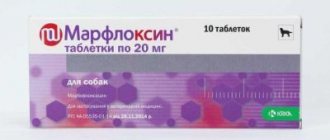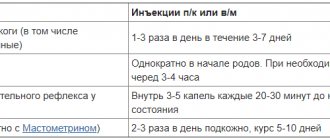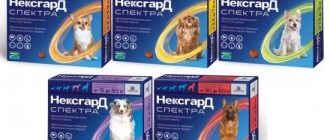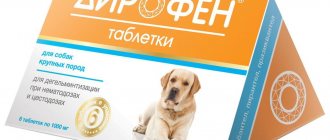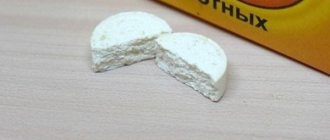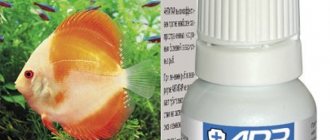What do they give from?
A veterinarian may prescribe Apoquel if, as a result of the diagnosis, the dog was diagnosed with dermatitis of the following types:
- flea;
- allergic;
- atopic;
- food allergy;
- contact;
- demodectic scabies.
Reference! If the cause of dermatitis is an allergy, then the veterinarian will prescribe a comprehensive treatment, including not only taking Apoquel, but also medicated shampoos, sprays, lotions and diet correction. This will speed up the healing process.
With pyoderma
In some cases, Apoquel is used as an adjuvant to relieve itching in pyoderma. Specific treatment and choice of medications depends on:
- intensity and area of damage;
- forms of pyodermatitis;
- dog's age;
- general health of the animal.
Does it relieve neurogenic itching?
Neurogenic itching occurs due to a signal coming from the central nervous system. Apoquel affects the external factors of the disease, so it will be useless for mental disorders.
Treatment of the disease primarily involves eliminating the stress factor and providing the dog with positive emotions. If neurogenic itching is chronic, the doctor may prescribe sedatives.
When and how to use
Apoquel is prescribed to cats for allergic dermatitis to eliminate itching and focal skin reactions in the form of redness, irritation, etc. The medicine is effectively used for allergies caused by various factors:
- fleas and other external parasites;
- feed and food products;
- cosmetics (shampoos, lotions);
- chemicals (powder, cleaning products, etc.);
- other irritants.
The drug is often prescribed for the treatment and prevention of relapses of atopic dermatitis, a disease in which symptoms appear for unknown reasons.
Since food has no effect on the absorption and effect of the active component, the tablets can be given along with food. They can be hidden in the animal’s favorite treats or simply added to the usual diet. If this number does not work with your cat, then you will have to give the medicine forcibly. To do this, place the tablet on the root of the animal’s tongue, and then stroke the animal’s neck to trigger a swallowing reflex. At the same time, the pet's head must be kept elevated so that it does not spit out the medicine back.
Apoquel should be given to cats once a day. A single dose is 0.4-0.6 mg of active substance per 1 kg of animal weight. Depending on the size of the pets, they are usually prescribed 0.5-1 tablet. The course of treatment is continued until the symptoms of allergic dermatitis completely disappear, but not more than 2 weeks. To prolong the remission of atopic dermatitis, Apoquel is given once a day, but the course can be longer. In any case, it is not recommended to give the medicine for more than 14 weeks in a row.
Important! The dosage and regimen of use can be adjusted by the doctor depending on the pathology and condition of the animal.
It is not recommended to skip medication. This usually negatively affects the effectiveness of the tablets. If it was not possible to avoid skipping, you need to return to treatment as soon as possible. The dose and regimen remain unchanged.
Dosage
The dosage of the drug depends on how much the animal weighs. It is very important to adhere to the doctor’s recommendations - do not increase or decrease it unnecessarily.
| Adult dog weight | Number of Apoquel tablets per dose |
| From 3.5 to 4.4 kg | Half tablet |
| From 4.5 to 5.9 kg | |
| From 6 to 8.9 kg | |
| From 9 to 13.4 kg | One tablet |
| From 13.5 to 19.9 kg | |
| From 20 to 26.9 kg | |
| From 27 to 39.9 kg | Two tablets |
| From 40 to 54.9 kg | |
| From 55 to 80 kg |
Composition and pharmacological properties
The main active substance of Apoquel is oclacitinib meleate. Additional components of the drug: lactose monohydrate, magnesium stearate, cellulose, film former.
- The dosage of the drug must correspond to the weight of the pet and is: 3.6 mg (S), 5.4 mg (M), 16 mg (L).
- On the surface of each tablet there is an inscription with the abbreviation of the drug (AQ) and the dosage - S, M or L.
The drug affects enzymes that provoke the appearance and development of allergic reactions.
Effect of the drug
Apoquel acts on the enzyme Janus kinase. Janus kinase, in turn, provokes the activity of biologically active components - cytokines, which appear during allergic manifestations. Being in the blood of an animal, these molecules cause itching and redness on the skin.
The medicine begins to act an hour after administration. The maximum effect is achieved 4 – 5 hours after administration. Efficiency is achieved after the first dose.
The effect of the drug lasts up to 24 hours. From 0.5 to 2 tablets of the drug per day is enough to maintain the therapeutic effect and half the dose to prevent relapses of the disease.
Indications for use
Apoquel is used to suppress all symptoms of allergic reactions and dermatitis:
- Atopic dermatitis.
- Contact erythroderma.
- Demodecosis.
- All types of allergies - food, seasonal, chronic.
- Preventive agent for dermatological relapses.
What drugs cannot be combined with?
Pharmacological interactions with anti-inflammatory, antimicrobial and antiparasitic drugs have not been established.
It is unacceptable to take Apoquel simultaneously with:
- anticonvulsants;
- immunosuppressants;
- preventive vaccination.
As for personal prevention, when working with Apoquel you need to:
- avoid direct contact with the drug;
- after work, wash your hands thoroughly with soap;
- Dispose of empty medicine bottles and do not use them for household purposes.
Important! If you accidentally take Apoquel or have an allergic reaction, go to the hospital immediately and do not forget to take the medicine with you.
Apoquel for dogs: what is it, general characteristics of the drug
This is the name of one of the most modern veterinary drugs used to combat allergies and their consequences (including autoimmune diseases). In addition, the drug can be used as an immunosuppressant. The proprietary international name is oclacitinib.
The mechanism of action is quite complex. But to explain in simple terms, the components of the drug inhibit the action of pro-inflammatory, pro-allergic and pruritogenic (they cause itching) substances (more precisely, cytokines) that work through enzymatic activity.
The drug allows you to effectively combat itching and inflammation that occurs as a result of the development of allergic reactions. One of the most important advantages of the drug is its safety for cytokines, one way or another involved in the process of hematopoiesis.
If the drug is used for a sufficiently long time, its inhibitory effect on the lymphoid tissue of the dog’s body is manifested (more precisely, the drug suppresses the activation of T-lymphocytes). This allows (in some cases) to use the drug to maintain a normal quality of life for pets suffering from autoimmune diseases (dangerous, only under the constant supervision of a veterinarian).
Release form
Currently, the drug is produced exclusively in tablet form. In appearance, these are quite large oval-shaped tablets, the color ranges from whitish-yellow to completely white. In the middle of each pill there is a clearly marked and fairly deep dividing line.
Packaging: 20 or 100 tablets. The drug is packaged in bottles made of dense white polyethylene. They are closed with a screw cap, equipped with a standard protection against opening by children (to open it, you need to press).
Proper storage, shelf life
Proper storage is the key to preserving the medicinal properties of the drug. The standard shelf life (starting from the date of manufacture stamped on the packaging) is exactly two years. Divided tablets can be stored for three days, also by placing them in any sealed bottle. If the expiration date has expired, use of the medicine is strictly prohibited. In addition, other rules should be observed during storage:
The drug should be stored at a temperature from 0 to 25° Celsius. Freezing the product is not recommended. The drug, which has been exposed to temperatures above 30° Celsius for several days, should not be used. Under such conditions, the destruction of the main medicinal components occurs, causing the therapeutic effectiveness to sharply decrease.
The medicine must be stored in rooms with normal air humidity. However, plastic containers forgive many liberties, but in high humidity environments they must be completely airtight.
Also, the medicine should be stored in places well protected from direct sunlight. The latter is detrimental to medicines, as it promotes their destruction into their constituent components. In addition, the drug should not be stored together with food (especially odorous ones).
Process of absorption in the body
The degree of absorption of the drug’s components reaches 90%: within an hour after administration, it actively begins to enter tissues and organs. This is confirmed by the concentration of the drug in the blood plasma, which reaches a peak within an hour after administration.
The concentration of the drug drops by 50% within three hours after administration, and after another six hours it is almost completely eliminated from the body. Excretion is carried out with urine. Since its components do not change in any way in the body, the load on the excretory system is minimal.
Cumulative properties (the ability to accumulate in the body) are weakly expressed, which is why the medicine belongs to the third class of danger. In recommended doses, the drug is considered absolutely safe for the health of the animal.
Composition of the drug
The medicine contains the following components:
- Oclacitinib is the main active ingredient. Depending on the type of tablet, each may contain 3.6 mg (labeled on the tablet AQ), 5.4 mg (labeled M) or 16 mg (labeled L).
- Specially processed cellulose, magnesium stearate, and sodium carboxymethyl starch are used as fillers.
- Lactose monohydrate.
- Opadry II White is used to create a stable coating on the surface of the tablets.
In addition, purified, demineralized water is used in the production of the medicine.
Side effects
Apoquel is a fairly mild drug - it rarely causes side effects. Most often they occur when instructions are violated or due to an increase in dosage. The list of side effects includes:
- Indigestion - most often manifests itself in the first days, as a consequence of the fact that the body rejects the components of the drug. As a rule, this goes away at the second or third appointment.
- Cystitis or exacerbation of a chronic disease.
- Demodicosis or exacerbation of a chronic disease.
Note! With uncontrolled use of Apoquel, the body's immunity is suppressed, and as a result, the risk of developing cancer increases.
What should you do if these effects appear?
A responsible and attentive owner will always notice that something is wrong with the well-being of his dog, especially if the breed is prone to allergic reactions.
If one or more components of Apoquel are not suitable for a dog, the symptoms of the underlying disease may intensify: unbearable itching, fever and lacrimation will appear. All that can be done in this case is to immediately contact a veterinarian for help.
Be prepared to tell your doctor about your last medication use and dosage.
Apoquel for dogs - instructions for use
So, we have looked at the basic nuances of Apoquel. But this is not the entire instruction for use. There are other important points that both owners and veterinarians themselves should remember.
How to give the drug
So how do you give medicine to dogs? Just like any other veterinary tablets for animals:
Since the film coating of the pills tastes sweet, many pets eat them on their own without any problems. In such cases, it is enough to give the required number of tablets by feeding them to the dog by hand.
This is not officially recommended, but there is nothing wrong with crushing the tablets and then mixing them with the food. In such cases, administering medication to the dog is a very simple task. Moreover, the presence/presence of food does not in any way affect the degree and speed of absorption of the drug components.
And only a few “stubborn” people have to give the medicine by force. In such cases, we recommend placing the tablets on the root of the tongue and massaging the animal’s throat so that it is guaranteed to swallow the medicine.
Dosage and other rules for using the medicine
Note that an experienced veterinarian should calculate the exact dose, since with a severe overdose there is a possibility of “implanting” the animal’s immune system. The dosage is relatively simple: 0.4-0.6 mg of oclacitinib per kilogram of pet’s live weight. The medicine is given twice a day, but not more than a week in a row.
Other options and rules of application:
- When treating recurrent cases of atopic dermatitis, the drug is used in the same doses, and also for no more than two weeks in a row.
- In doubtful cases, it is strongly recommended to conduct a biochemical blood test and other tests (since it is necessary to accurately determine the causes of the pathology).
- You should always make sure that the dog has swallowed the required amount of the drug. Even skipping a medication twice can significantly reduce the overall effectiveness of the therapeutic course.
How long can you drink?
According to the instructions, the duration of drug therapy to eliminate systemic itching ranges around two weeks. The optimal treatment period is determined by the attending physician. It is strictly forbidden to independently extend the course of Apoquel in order to avoid the development of negative manifestations.
To maintain a healthy condition with atopic dermatitis, the doctor may reduce the dosage by half and prescribe lifelong use of the drug.
Is it addictive?
Unlike most antihistamines, Apoquel is not addictive. If necessary, the drug can be discontinued or reduced without consequences for health.
I. General information
- Trade name of the drug: Apoquel. International nonproprietary name: oclacitinib.
- Dosage form: tablets for oral use. Apoquel is available in three dosages, containing 1 tablet as the active ingredient oclacitinib maleate (in terms of oclacitinib) 3.6 mg; 5.4 mg and 16 mg, respectively, as well as excipients: microcrystalline cellulose, lactose monohydrate, sodium carboxymethyl starch, magnesium stearate, Opadry II White film former and purified water.
- In appearance, Apoquel is an oval tablet of white or almost white color, film-coated, with a dividing groove in the middle and with the inscription on both sides of the tablet: “AQ” and “S” (for a dosage of 3.6 mg), “M” ( for a dosage of 5.4 mg) or “L” (for a dosage of 16 mg). The shelf life of the medicinal product, subject to storage conditions, is 2 years from the date of manufacture. Unused halves are stored for no more than 3 days, placed in a bottle. Do not use Apoquel after the expiration date.
- Apoquel is produced packaged in 20 or 100 tablets in bottles made of dense white polyethylene with a screw-on polypropylene cap that is inaccessible for children to open, or in blisters of 10 tablets. Blisters are packed in cardboard boxes of 2, 5 or 10 blisters. Each package of the drug comes with instructions for use in Russian.
- Store the drug in the manufacturer's sealed packaging, in a place protected from direct sunlight, separately from food and feed at a temperature of 2°C to 25°C.
- Apoquel should be stored out of the reach of children.
- Unused medicinal product is disposed of in accordance with legal requirements.
- Apoquel is available without a veterinarian's prescription.
Owner reviews
Anna, owner of a 4-year-old cat:
“Our Leopard suffers from atopic dermatitis. We tried a bunch of medications and treatments. Steroids help, but there are simply countless side effects. The vet recommended Apoquel. The drug is expensive, but after 2 weeks of use the cat returned to normal. After stopping the course, itching, scratching, swelling and inflammation returned. Treatment was resumed. We have been taking the medicine without a break for more than 6 months. During periods of exacerbation, we increase the dosage, and during remission, we reduce it. This is the only salvation for our cat.”
Marina, owner of a Persian cat:
“Due to a severe allergy, the cat simply began to tear out her hair. The front legs, areas on the stomach and sides became simply bald. This spectacle is impossible to watch. Drank Apoquel. He didn't help us at all. Chloe continued to itch and pull fur out of herself. Expensive and useless."
Reviews from veterinarians
Vladimir Petrovich, veterinarian with 18 years of experience:
“I learned about Apoquel at a conference that was held in our city. Colleagues spoke well of the drug. Before using it in my practice, I decided to find out more information. I found the results of studies of the drug on cats by Italian veterinarians. During these studies, the effectiveness and safety of the drug was proven. Now I often use it to treat dogs and cats. I can confirm that the medicine relieves itching perfectly, but you should still use it as prescribed by a doctor.”
Valentina, veterinarian with 12 years of experience:
“Apoquel is a good alternative to steroids for severe itching. It works great. I often see reviews online that the pills don’t work. I'm more than sure that this is a fake, of which there are a lot on the market. Our clinic purchases the drug from trusted pharmacies, and the medicine has never failed. Be careful when choosing a seller."
